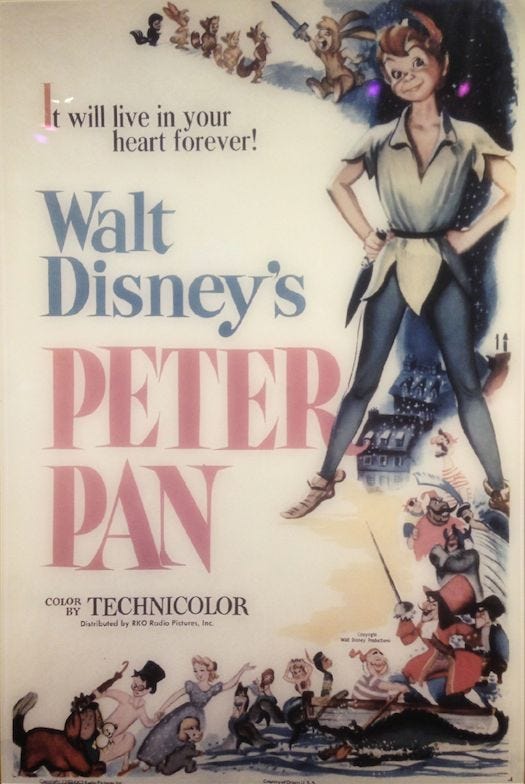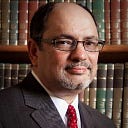History of Peter Pan: the Disney Classic at 67

All of this has happened before,
and it will all happen again.
So begins my favorite Walt Disney animated movie, Peter Pan, which debuted 67 years ago today on February 5, 1953. The original movie poster said:
“It will live in your heart forever”
…and indeed it has. Why was this turn-of-the-century tale one of Disney’s favorite stories?
Walt Disney
It’s because Walt Disney was Peter Pan. Am I suggesting that because he was “the boy who wouldn’t grow up?” Perhaps, but what I really mean is that Walt Disney performed Peter Pan as a child. How did that happen?
Play
First, we must begin by recognizing that Peter Pan came to notice in the 1904 stage play by James Matthew Barrie, a Scottish author and playwright. It was first performed in London where he’d previously met the Llewelyn Davies boys, whom he later adopted. They were the inspiration for the boy who has adventures in nearby Kensington Gardens in London and the magical Neverland. Barrie wrote “Peter Pan, or The Boy Who Wouldn’t Grow Up” a play about an ageless little boy and a London girl named Wendy.
J.M. Barrie
What is not as well know is that J.M. Barrie was himself the “boy who wouldn’t grow up.” When James was 6, his older brother David died at the age of 13 in an ice-skating accident. His mother was overcome with grief as David was her favorite son among her 8 children. James would dress in David’s clothing and whistle as he had in an attempt to fill the void in his mother’s heart. He wrote in his biography of his mother that she found comfort with the idea that her dead son would forever be a boy who would never grow up and leave her. Indeed even physically J.M. Barrie never grew above 5 feet 3 and a half inches.
America
The play, later published as the novel Peter and Wendy in 1911, debuted just after Christmas on December 27, 1904. A year later, it was seen on Broadway starring Maude Adams one of the most popular American stage actresses at the time. She subsequently took it on a national tour and J.M. Barry wrote several plays for her.
Home town
Marceline, Missouri was on the Santa Fe railway line when the tour rolled west. (By the way, Marceline at the turn of the century was the inspiration for Disneyland’s Main Street.) Walt Disney saw the play and was enthralled. Later, a classmate at Park Elementary School produced his own version with Walt in the starring role. With his brother Roy manning the block and tackle, Walt Disney portrayed Peter Pan. He recollected that as a boy when the block and tackle once gave way, he flew directly into the laps of the audience. Disney said,
“No actor ever identified with the part he was playing more than I.”
Since 1935, Disney had intended to make a movie about Peter Pan and had finally acquired rights to it in 1939 from the Great Ormond Street Hospital in London — to whom Barrie had given the rights to the play. In 1940 Disney wrote to Maude Adams, who had since retired to teach drama at Stephens College, informing her of his plans to create a feature-length animated movie of Peter Pan. He wanted to submit an early scenario of the film for her approval before going into production. She declined, it was believed, because “the Peter whom she created was to her real life and blood, while another’s creation of this character would only be a ghost to her.” Disney said that Miss Adams was simply living in the past.
Delay
Because of World War II, the project was shelved until 1950 when the creative team shifted from the movie Alice in Wonderland to Peter Pan. With it came the last collaborative effort of the “Nine Old Men” a group so-called by Disney that had created the animated classics. From Alice in Wonderland came the voice talents of Kathryn Beaumont (Alice/Wendy), Bill Thompson (White Rabbit & Dodo/Mr. Smee), Heather Angel (Alice’s sister/Mrs. Darling) Also, the opening melody “The Second Star to the Right” was a discarded song from Alice in Wonderland, repurposed for Peter Pan.
Disneyland
The Disneyland “dark rides” were designed by many of the same animators who had worked on the original feature films. This pedigree brought with it new levels of artistry never before seen in an amusement park, according to the Walt Disney Imagineering Collection. Peter Pan’s Flight remains, as from its opening in July 1955, one of the most popular rides at Disneyland. It is my personal favorite, perhaps the boy with the pointed ears reminds me of a certain Vulcan. But Peter can fly, and he can teach other children to fly, a favorite fantasy and dream. And isn’t Disneyland the place “where dreams come true”?
Movie
Disney’s movie starts in the Bloomsbury neighborhood of London, near Kensington Gardens — where today along the Serpentine River you can find a statue of Peter Pan — and then the children fly to the clock face of Big Ben. As they begin their adventure to Neverland the clock reads 8 pm when they return it reads 11 pm, the typical length of a London play. Then they fly over the Thames, the Tower of London, the Tower Bridge, and the river stretching out east to the sea.
Musical
The story went on to become a popular musical play (1954) and television show (1960) starring Mary Martin, as well as live-action movies including a cathartic Steve Spielberg movie called Hook with Robin Williams. In the ’70s I saw the rock opera version of Peter Pan in San Francisco. The Disney film was re-released theatrically in 1958, 1969, 1976, 1982, and 1989. It was released on VHS tape in 1990. In honor of the 61st anniversary, it was released as Blu-ray DVD Diamond Edition. It spawned a sequel “Return to Never Land” and a series of Tinker Bell “Disney Fairy” videos.
J.R.R. Tolkien‘s biographer Humphrey Carter even thinks the 1910 performance of the play in Birmingham “may have a little to do with” Tolkien’s impressions of the Elves of Middle Earth.
Trivia: at the very beginning of every Walt Disney Pictures film, in the clouds above the castle, you can see the two stars in the sky, including the second one to the right.
Peter’s directions to adventures in Neverland were the same as the last orders of Captain James Hook Kirk, in Star Trek 6: The Undiscovered Country…
Second star to the right and straight on till morning.
Bill Petro, your friendly neighborhood historian
www.billpetro.com
If you enjoyed this article, please consider leaving a comment or subscribing to the news feed to have future articles delivered to your feed reader or your email.
